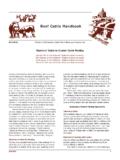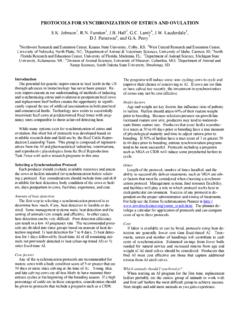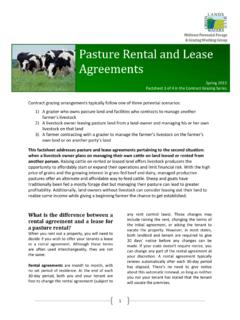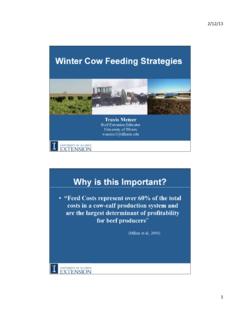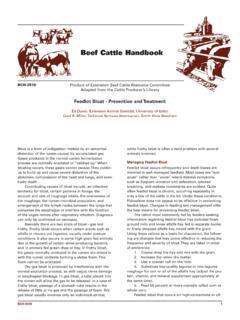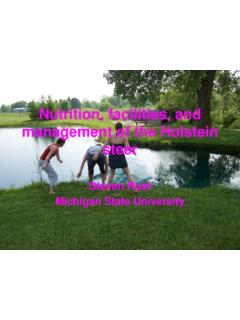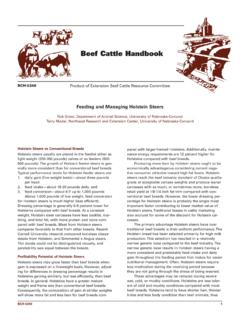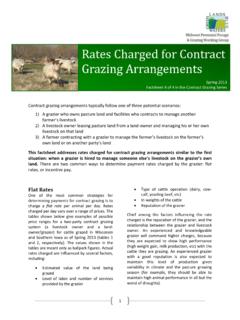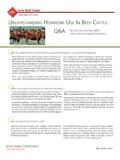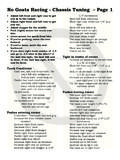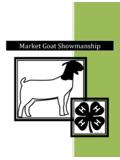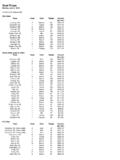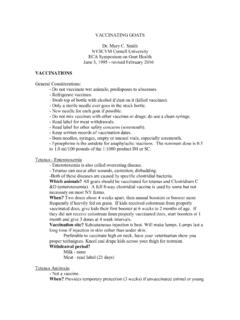Transcription of Raising Meat Goats on Pasture.ppt - Iowa Beef Center
1 8/31/20101 Raising Meat Goats on PastureMark KennedyState Grazinglands SpecialistUSDA-NRCS&Meat goat producerTop 10 Reasons Not to Raise have to be smarter than everything that wants to kill have to be smarter than keeping them in! problems (kidding,parasites) of infrastructure (marketing, veterinary expertise, animal health products, feed products, knowledge, research) labor requirements (kidding, hoof care, parasite control, ,marketing)10. You re not going to get rich quickManagement Considerations Predator Control Fencing Facilities Parasite Control Pasture & Grazing Management Marketing AdvantagesPredator Control Guard Animal + Effective Predator Fencing Guard dog, Llama, donkey - dogs best on larger and brushier farms. Llamas and donkeys work well on smaller operations.
2 Fencing - 7 - 8 wire HT power fence for perimeterFencing for Sheep & Goats HT electric/power 6 - 8 wire perimeter 2 - 6 wire interior Woven wire 39 + 1-2 barbed or electric Wider mesh preferredElectric Fencing Both sheep & Goats can be trained to respect electric fencing Perimeter should be 6 -8 wires at least 42 tall10 8 wires at least 42 tall bottom wire 6 - 8 from the ground 6 to 12 inch spacing between wires alternating hot and ground wires6 6 6 6 8 10 42 8/31/20102 Goats can be controlled with 3 or more strands of HT electric wire for subdivision fencing 2 polywires have been flfsuccessful for stripgrazing as long as forage supplies are adequate Electric netting is also available for temporary fencingElectric Gate Ozark Styleutilizing 6 - 8 strands of polytape and UV stablized PVC pipe5 UV stabilized PVC 2 diameterRun jumper wire from fence to gate(not shown in this picture)6-8 strands of polytape6 strands starting 8 off the ground and maintain 8 spacing puts top wire at 48 leaving 1 to put loop over(not shown in this picture)You can connect polytape to postswith eye-bolts, J-hooks or simply make cotter pins out of high tensileand loop polytape throughConventional Fencing Woven wire is effective but expensive 6 x 12 mesh is preferred to minimize horned Goats getting caught Wider spacing (24 36 )
3 Now available, less expensiveConventional Fencing May run an electric offset wire 12 - 15 from the ground to reduce animals getting caught or climbing on fence68t db bd i 6 -8 strand barbed wire can work or 4 - 5 strand with at least 2 electric offset wires. Conventional fencing is generally more expensive and less flexibleGoats will need some type of shelter from rain and other weather extremes. Goats don t like to get wet and are less tolerant of cold/wet than sheep or cattle!Natural shelterShelterPortable shelter thatcan be used as a portable creep feederfor kids.(mineral feeders attached)Shelter Barn Space 10 15 sq. ft. per animal in open housing with pasture 20 sq. ft. - 30 sq. ft. exercise area inexercise area in confinement systems Open shed 8 10 sq. ; 4 6 high in rear; 6 8 high in front; open to south Lambing/Kidding Jugs 4 x 4 5 x 5 8/31/20103 Handling small numbers of sheep and goatsLarge penSized to fit entire herd A pen where the sheep/ Goats can be crowded is usually sufficient.
4 Get in pen and restrain sheep/ Goats by horns, under chin, with halter, against gate, straddling them, penentire herd2 4 sq. ft/ kid5 6 sq. ft/doeTo pas ture o r loading ramp, Feed sheep/ Goats in pen to get them used to it. Be careful of horns and sudden sidesHandling large numbers of sheep and Goats A more elaborate handling system is usually required. Can be permanent or portable. Can be constructed from steel, aluminum, or wood. Can be homemade or purchased. Chute 10 long x 4 high x 12 wide solid sidesParasite Control/Prevention Parasites can be major problem Control and Prevention need to be planned Select animals for parasite resistance Grazing managementGrazing management Watch grazing heights not less than 4 Longer rest periods to help break cycle (>40 days) Grazing cattle in rotation with sheep or Goats Haying in rotation Cropping in rotation Strategic Deworming program FAMACHA & FECG raze cattle or cut hay in combination with rotational grazing1.
5 Have an 8 paddock or more grazing system in place2. Start rotating Goats /sheep through half hddkthe paddocks3. Cut hay or have cattle grazing through other half4. When each herd finishes cycle through half switch to other side5. Same can be done with hayRotate with Cattle or Hay Move every 3 5 days Gives each pasture a 15 30 day rest Gives double that forGoatsCows/HayGives double that for each species of livestock Helps maintain forage quality & clean up pastures Can be done with hay alsoGrazing ManagementObjectives: Manage forage to meet animal nutritional needs Maintain pasture condition/health Manage internal parasite levelsManage internal parasite levels8/31/20104 Strategies: Utilize proper stocking rates Don t overstock Utilize animal grazing behavior to an advantageg Proper grazing heights Utilize browse Utilize plants high in taninsStrategies, cont d.
6 Utilize rotational grazing management Manage plant rest periods for plant health, forage quality, lower parasite levels Utilize cattle or hay in rotationUtilize proper stocking rates Lower stocking rates & higher residuals will generally have less of a parasite build up in the pastureHow many Goats can you stock?Pasture is often the most limiting resource. Pasture stocking rates vary by .. Pasture quality/production Rainfall: amount and distribution. Pasture species Time of year/month/season Soil fertility lime, N, P, K Amount of supplementation Grazing managementcontinuous, rotational, intensiveGoat eating chicoryHow many Goats can you stock? It depends upon your management system and resources. Each farm has a different set of resources to use to raise livestock.
7 Land, labor, management and capitalCarryingCapacity=ForageProduction XSeasonalUtilization RateDailyIntakeXLength of theGrazing SeasonStocking Rate GuidelinesPasture Type Cows Sheep Goats Cows + Goats Excellent Pasture 1 5 - 6 6 - 8 1 + 1 2 Brushy Pasture 1 6 - 7 9 - 11 1 + 2 - 4 Brush Eradication Sustainable browse mgmt. 8 12 / ac 1 3 / ac .5 + 6 8/ac Kennedy - 20028/31/20105 Match animals to resources A lot of the health and other problems with sheep and Goats is directly related to not letting a goat be aletting a goat be a goat or a sheep be a sheep they are ruminants! Use animals that fit your land and forage resourcesForbDiet PreferencesGoatsSheepBrowseGrassForbsGra ssSheepCattleHowever, there is regular crossover among the 3 types of feeders as diet preferences and food availability changes throughout the Habits/Preferences Goats Prefer browse over grass Prefer some forbs over grass Prefer grass over clover Prefer taller plants Prefer rough, steep land over flat, smooth Tend to graze perimeter before Center of pasture Graze from the top down Don t like to graze closer than 4 Graze in uniform layersGrazing Preference dependent on forages available, animals experience.
8 Stock density and timing Desirable Browse Multiflora rose Blackberry Greenbriar Honeysuckle Desirable Forbs Chicory Lespedeza Red clover Ragweedy Honey locust Sumac Willow Persimmon/sassafras Oak Walnut Wild Grapeg Lambsquarter Sericea Kudzu Crown vetch Poison ivy/oak Spotted knapweed PigweedGrazing Preference dependent on forages available, animals experience, stock density and timing Desirable Grasses Tall fescue (vegetative & fall stockpile*) Ryegrass Rye wheat oats Intermediate Grasses Bermudagrass Bluegrass Broomsedge Rye, wheat, oats cheat - spring preference* orchardgrass Crabgrass (taller) foxtail, purpletop, barnyardgrss - pre head Most NWSG Caucasian bluestemGrazing Preference dependent on forages available, animals experience, stock density and timing Intermediate Forbs Ironweed Spiny amaranth Curly dock Pokeweed Intermediate Browse Cedar Buckbrush Hickory Pokeweed Buttercup White clover Thistle Bur dock Ox-eye daisy Queen Anne s lace8/31/20106 Undesirable Species Horsenettle Perilla mint Wooly CrotonGrazing Preference dependent on forages available, animals experience, stock density and timing Wooly Croton Lanceleaf Ragweed (until after frost) Wild Cherry (poisonous if wilted) Switchgrass (may cause photosensitivity) Alsike clover (may cause liver damage)
9 Utilize goat grazing behavior to an advantage Include browse plants in grazing system Goats love browse The higher from the ground they eat the less likely they are to pick up parasite larvae A lot of browse plants are higher in tannins High tannin diets reduce reproduction of internal parasitesUtilize grazing behavior to an advantage Utilize plants high in tannins Goats tend to intake higher levels of tanninshigher levels of tannins than other ruminantsPossible Plants with Condensed Tannins or other Secondary Compounds that Help Control Internal Parasites? Sericea Lespedeza Annual lespedeza Oak leaves/acorns Walnut leaves Birdsfoot trefoil Arrowleaf clover Berseem clover Crown vetch Chicory Mulberry Mimosa Acacia Autumn olive Multiflora-roseUtilize rotational grazing management To manage forage quality to meet animal nutritional needs To maintain pasture pcondition/health To manage internal parasite levels8/31/20107 Plant Growth Phases BeginEndGrazing in the Spring Keep pastures vegetative early boot Rotate frequently (no longer than 5 days in a pasture)
10 - increases intake of high quality plants prevents regrowth from being eaten too soon Rest pastures 20 30 days allow plants time to recover and provide adequate quantity of high quality forage Rotate with cattle or hayingGrazing During Summer Try to have cool season pastures fully utilized by the end of June then rest all summer if possible For summer graze warm season grass For summer, graze warm season grass pastures, lespedeza, alfalfa, chicory Taller growing natives allow the animals to graze higher off the ground Provide by-pass proteinGrazing During Summer Graze regrowth in hayfields that were cut in spring Utilize weedy/brushy pastures during summer Hinge cut cull trees from woods for Goats to browse Allows Goats to eat higher off the ground Provides high tannin diet Allows cool season pastures to restGrazing during Fall & Winter Start using cool season pastures again They have had a 60 90 day rest during the summer Defer grazing on some pastures to stockpile for winter grazing Allow warm season pastures to rest all winter Rotate similar to spring but stay in each pasture a little longer to give a longer rest period (35 40 days)
